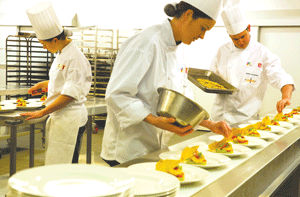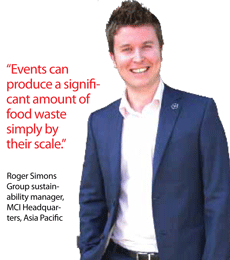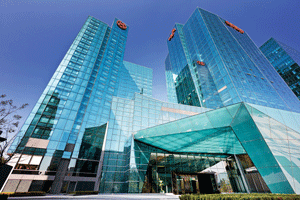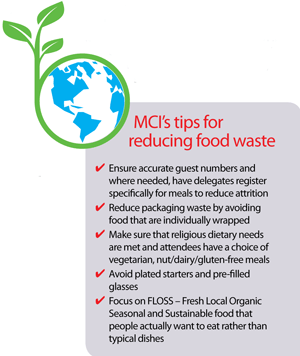
Rising global food demand and waste is stressing the Earth. With the extent of F&B featured in business events, venues in Asia are doing their part to minimise impact on the environment, writes Karen Yue
As any good, hospitable host will ensure his guests are well entertained and nourished, business event organisers spend considerable effort developing strong content that educates attendees and opens new business avenues for them, as well as on how they are fed during welcome receptions, refreshment breaks in between meetings, networking cocktails and closing dinner galas.
In Asia, where it is customary to demonstrate hospitality with an overflowing supply of good food, the amount of food consumed and wasted should give pause to event organisers and venue operators especially at a time when satisfying global food demand has become one of the biggest environmental threats.
Environmental experts have blamed agriculture for being the biggest cause of global warming, due to the massive volume of greenhouse gases emitted by cattle and farmland, and through the clearing of land for farming. Farms also consume a lot of water while fertilisers pollute water systems.
Agriculture’s impact on the environment is bound to intensify with the growing need for food. The Food and Agriculture Organization of the United Nations (FAO) projects that, under current production and consumption trends, global food production must increase 60 per cent by 2050 in order to meet the demands of the growing world population.
More events equals more food?
Considering how several dining activities are featured at business events, which are on the rise at major venues in Asia, is the MICE industry adding to this environmental woe?
According to Kevin Teng, executive director of sustainability at Marina Bay Sands in Singapore, there is a direct correlation between the amount of food prepared and business volume. While the integrated resort is unable to provide quantitative information on the extent of food consumed at business events held there, Teng said all team member dining rooms serve up to 7,000 meals daily.
Just how much goes into the belly?
A post-event sustainability report prepared by MCI Headquarters and Marina Bay Sands for the 500-pax Responsible Business Forum on Sustainable Development last year, found that the event had generated 215kg of food waste.
“Food waste is one of the highest streams of solid waste for events,” declared Roger Simons, group sustainability manager of MCI Headquarters, Asia Pacific.
“Events can produce a significant amount of food waste simply by their scale. A 6,000-pax congress (with a no-show of) 20 per cent for an evening function results in 1,200 meals being wasted.”
Chucking food is a crying shame at a time when food demand is high but not equally distributed globally, causing some nations to starve. Food disposal is also cause for concern because it generates methane emissions, which also contributes to global warming, warned FAO.
Fortunately, some venues have told TTGmice that a large portion of food prepared for business events goes into the bellies of delegates.
At the Kuala Lumpur Convention Centre, 95 per cent of food prepared for an event is consumed, while the Melbourne Convention and Exhibition Centre reports that the consumption rate is 90 per cent.
To minimise food wastage during events, venues have developed ways to calculate how much food is needed.
Chen Soo Yoong, director of facilities at Kuala Lumpur Convention Centre, said: “We have a formula to calculate the amount of food required for a particular event. This formula has been enhanced over the years based on our experience and the consumption rate for a variety of events held here.”
Marc van der Meer, director of food & beverage at Melbourne Convention and Exhibition Centre, said his venue uses a specific ratio system that is “based on the number of people being served, the type of event and the menu items ordered”.
Sheraton Beijing Dongcheng Hotel actively tracks food wastage from each event, compares that with its food requirement estimates and makes adjustments, if necessary, for future events.
Meanwhile, Marina Bay Sands has spent the past 12 months developing a food waste tracking system “to monitor each meal option served and the waste generated in our team member dining rooms. With this tracking system, we are not only able to actively reduce food costs but also overall wastage”, revealed Teng.

Internal push
All the venues TTGmice spoke to said they are committed to sustainable practices and have procedures to follow and goals to meet.
Ross Grinter, hotel manager of Sheraton Beijing Dongcheng Hotel, said: “Sustainability is a key goal of all Starwood hotels as we want to ensure our business is run in an environmentally responsible manner that is integrated with the local community. We have aggressive goals as an organisation to meet this objective, and accordingly, our management team gives a great deal of focus to both reducing energy consumption from our daily operations and minimising food wastage.”
The hotel manages food waste by directing excess food that has not yet left the kitchen to the internal staff canteen and by composting leftovers.
Melbourne Convention and Exhibition Centre has an employee Environmental Taskforce dedicated to enhancing sustainability initiatives, which include looking at ways to reduce food waste. “We were the first convention centre in the world to be awarded a six-star Green Star environment rating, something we work hard to maintain,” said van der Meer.
Reducing waste in general is a priority for Kuala Lumpur Convention Centre. “To cut down on food waste, the venue practises bookshelf cooking, whereby nonperishable items are pre-cooked and stored to be made à la minute. This keeps food fresh and reduces (over-production). Where possible, non-exposed food prepared for events but not consumed are served in the staff canteen while nonperishable (meat) is used for stock,” explained Chen.
On top of that, the centre has a licensed contractor who collects waste and turns food waste into fish food for local fish farms. These combined efforts have allowed the centre to reduce its annual food waste from 69 tonnes in 2010 to 37 tonnes last year, said Chen.

Teng said: “We continually run food waste awareness programmes such as monthly clean plate activities in the team dining room. Team members are reminded and encouraged to take only the required amount per serving.”
Marina Bay Sands also transfers unconsumed food prepared for buffet lines to executive team dining rooms and channel subsequent food waste to a processor that decomposes and breaks down such waste into clear reusable water that is then pumped into the public waste water system. As of October this year, the system had converted up to seven tonnes of food waste to water, Teng said.
MCI Headquarters believes that venues with strong sustainability policies have an advantage in winning over event clients.
Simons said: “(We) have definitely seen a rise in corporate clients requesting for venues and suppliers with solid sustainability practices. Brands like Schneider, BASF, Oracle, Symantec and Intel are making it a strong requirement and many feature sustainability as a core part of their event programme.
“There is no denying that the trend is led by North America and Europe, but we are seeing global companies making commitments to responsible business wherever they are.”
Charitable solutions
Another way of minimising food waste is to direct surplus food to charities.
Melbourne Convention and Exhibition Centre has been working with community food programme SecondBite for the past six years and OzHarvest since January 2014. Surplus food suitable for donation is kept refrigerated while collection arrangements with the charities are made. Donation amounts vary according to the events being held at the centre.
Non-profit organisation Food from the Heart receives unconsumed bread from Marina Bay Sands’ buffet lines. According to the property’s spokesperson, Val Chua, some 2,400 pieces of bread are donated per month to the charity. Event clients are also encouraged to take part in this bread donation exercise.
Presently, Sheraton Beijing Dongcheng Hotel is “exploring options to partner with charities”, said Grinter.
Reaching out to clients
Venues are working closely with event clients to achieve smarter food management, by advising them on F&B requirements and providing options to manage unconsumed food responsibly.
Melbourne Convention and Exhibition Centre, for instance, can arrange for leftovers brought in by event visitors to be donated to one of its charities.
Marina Bay Sands’ ECO360° meeting packages offer planners the option to achieve waste targets for their events. Planners can also pick sustainably sourced F&B options from the Harvest Menu. An even more valuable option for planners comes in the form of the Sands ECO360°Event Impact Statement, a post-event report that consolidates sustainable event metrics such as energy and water consumption, recycling rate and carbon emissions.
Chen observed that “clients in general are willing to listen and act on our advice and expertise”.
MCI Headquarters can also produce post-event reports for its clients.
“We’re encouraging as many clients as possible to be transparent about their event’s impact. As you can imagine there is a fair amount of time and resource required in engaging suppliers, tracking the relevant data and then calculating and presenting the information in an engaging manner, so not all clients want to head down this path,” said Simons.






















